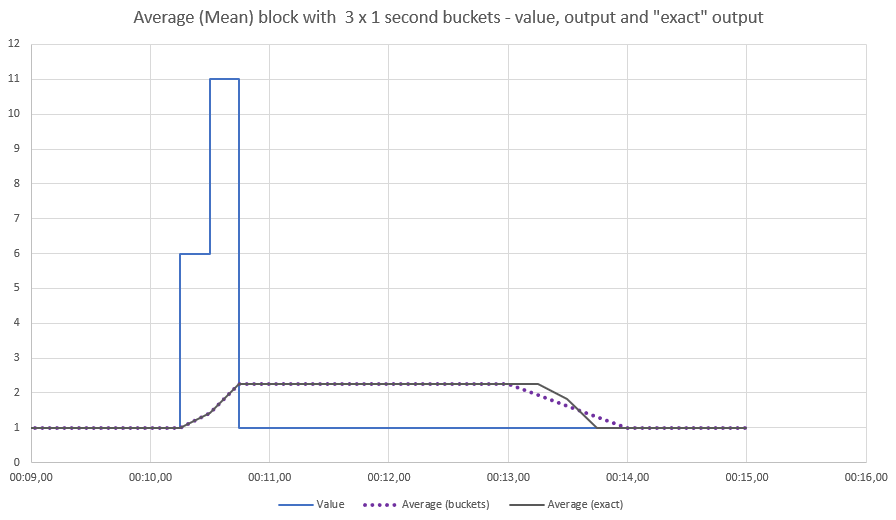Windows and buckets
A number of blocks, primarily those in the Aggregate category, maintain a time-based window of input values received in the past. Their output is a calculation based on values within this window. Typically, such blocks offer two distinct ways of managing this window:

A parameter value specifying the duration of the window. If set, the window automatically expires interpreted values older than the time specified (where interpreted values are the latest received value at any point in time, as described in
On-change inputs and time windows). If the parameter is not specified, then the block does not automatically expire any data.

A reset input. When a signal is received, the contents of the window is cleared and the block resets to having no contents.
It is possible to use these in combination, or neither, but more typically one or the other.
For the case of the window duration being specified, the block must be able to expire old data. A strictly exact implementation of this would be to store each different measurement input along with the time it occurred. For long windows and/or high frequency inputs, this can result in a large amount of data being stored. To avoid an excessive amount of data being stored, the product blocks do not store all measurement values and times. Instead, the window duration is divided into equal-size buckets. The blocks store state per bucket and use that information to re-calculate the output of the block. A historic bucket can either be completely within the window or be partly expired. If a bucket is partly expired, then the block applies a fractional proportion of the values within that bucket. The practical effect of this is that if the value is changing without significant fluctuations, there is only small difference between an exact (but more resource-intensive) implementation of the block and one that uses buckets. If there is a significant fluctuation in the input value that causes a shift in the output, then the exact time of individual measurement inputs is lost, and the effect that the significant value has as it expires will be spread in time by up to one bucket duration. The product blocks use 20 buckets as a reasonable compromise between accuracy and efficiency.
To illustrate this, we exaggerate the effect by simulating an Average (Mean) block with 3 buckets and a 3 second window, so each bucket is 1 second in duration. A few anomalous readings (after a continuous input of value 1) affect the average for both exact and bucket-based Average (Mean) blocks in the same way, but we can compare the result of exactly expiring each value exactly 3 seconds after it occurred with using buckets, where the change in output is smoothed over the bucket duration:
Note that not only is the timing of the expiry of the anomalous values less precise, the exact shape of the output is lost. The bucketed average changes uniformly between time 00:13 and 00:14. Remember, the product blocks use 20 buckets, so the effect would be less pronounced in this case.
